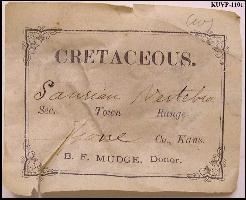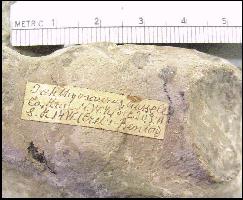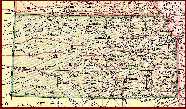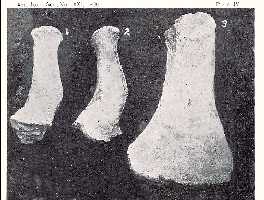Publications of B. F. Mudge
Mudge, B.F. 1866. First Annual Report on the Geology of Kansas. State
Printer. 57 pp. (first mention of "exogenous leaves" in sandstone)
Mudge, B.F. 1866. Discovery of fossil footmarks in the Liassic (?) Formation
in Kansas. Amer. Jour. Sci., ser. 2, 41(122):174-176.
Mudge, B.F. 1868. On a meteorite which exploded over Kansas, June 6, 1868. Am. Jour.
Sci. ser. 2, 46(138):429-430.
Mudge, B.F. 1872. Red sandstone of central Kansas. Kansas Acad. Sci. Trans.
1:37-39. (Dakota Sandstone Fm., fossil leaves, invertebrates)
Mudge, B.F. 1872. Geology of the Arkansas. Kansas Acad. Sci. Trans. 1:50-53. (Arkansas
River west of Hutchinson, KS)
Mudge,
B.F. 1873. Red sandstone of central Kansas. Transactions of the Kansas
State Board of Agriculture, State Printer, pp. 394-396.
Mudge, B.F. 1873. Geology of the Arkansas. Transactions of the Kansas
State Board of Agriculture, State Printer, pp. 408-410.
Mudge, B.F. 1873. Footprints in the middle Coal Measures at Osage, Kansas.
Amer. Jour. Sci. ser. 3, 5(28):228.
Mudge, B.F. 1873. Recent discoveries of fossil footprints in Kansas. Kansas
Acad. Sci. Trans. 2:71-74.
Mudge, B.F. 1874. A geological survey of Kansas. Kansas. Acad. Sci. Trans.
3:101-102.
Mudge, B.F. 1874. Pliocene Tertiary of western Kansas. Kansas Acad. Sci. Trans.
3:113-117.
Mudge, B.F. 1874. Rare forms of fish in Kansas. Kansas
Acad. Sci. Trans. 3:121-122 (Agassizodus
tooth plate)
Mudge, B.F. 1876. Notes on the Tertiary and Cretaceous periods of Kansas.
Bull. U.S. Geol. Surv. Terr. (Hayden), 2(3):211-221.
Mudge, B.F. 1877. Notes on the Tertiary and Cretaceous periods of Kansas. pp. 277-294, in
Part I (Geology) of the Ninth Annual Report, U. S. Geol. and Geo. Surv. Terr. (Hayden),
for 1875, 827 p.
Mudge, B.F. 1877. Annual Report of the Committee on Geology, for the year
ending November 1, 1876. Kansas Acad. Sci. Trans., Ninth Annual
Meeting, pp. 4-5. (discovery of Uintacrinus socialis in Kansas, Pteranodon,
sharks and birds.)
Mudge, B.F. 1877. Bison latifrons in Kansas. Kansas Acad. Sci.
Trans. 5:10.
Mudge, B.F. 1877. Flesh fossilization an impossibility. Western Review of
Science and Industry 1(8):484-485.
Mudge, B.F. 1877. Fossilization of flesh. Western Review of Science and
Industry 1(10):625-626.
Mudge, B.F. 1877. Fossil leaves in Kansas. Western Review of Science and
Industry 1(10):654-656.
Mudge, B.F. 1878. Geology of Kansas. Pages 60-63 in First Biennial Report of the Kansas
State Board of Agriculture. Topeka.
Mudge, B.F. 1878. Cretaceous forests and the migrations. Kansas Acad. Sci.
Trans. 6:46-48. (fossil leaves)
Mudge, B.F. 1878. Internal heat of the earth. Kansas Acad. Sci. Trans. 6:48-51.
Mudge, B.F. 1879. The new sink-hole in
Meade Co., Kansas. Kansas City Review of Science and Industry 3(4):152-153.
Mudge, B.F. 1879. Are birds derived from dinosaurs? Kansas City Review of
Science and Industry 3:224-226.
Mudge, B.F. 1880. Man and Evolution. Kansas City Review of Science and
Industry 3(9):515-523. (published posthumously)
Mudge, B.F. 1881. List of minerals found in Kansas. Kansas Acad. Sci. Trans. 7:27-29.
(Mudge died in 1879, published posthumously)
OTHER REFERENCES WHICH MENTION MUDGE OR HIS TIMES:
Clarke, J. A. 2004. Morphology, phylogenetic taxonomy, and
systematics of Ichthyornis and Apatornis (Avialae: Ornithurae). Bulletin
of the American Museum of Natural History 286: 1-179.
Cope, E. D., 1870. [Notes on mosasaurs of New Jersey, New Mexico
and Kansas.] Proc. Amer. Phil. Soc., 11(85):571-572.
Cope, E. D., 1871. On some species of Pythonomorpha from the Cretaceous beds of Kansas and
New Mexico. Proc. Amer. Phil. Soc. 11(85):574-584.
Cope, E. D., 1871. On the fossil reptiles and fishes of the
Cretaceous rocks of Kansas. Art. 6, pp. 385-424 (no figs.) of Pt. 4, Special Reports,
4th Ann. Rpt., U.S. Geol. Surv. Terr. (Hayden), 511 p. (Cope credits Mudge for a number of
discoveries)
Cope, E. D., 1872. Note of some
Cretaceous Vertebrata in the State Agricultural College of Kansas. Proc. Amer. Phil.
Soc. 12(87):168-170.
Cope, E. D., 1874. Review of the vertebrata of the Cretaceous period found west
of the Mississippi River. U. S. Geol. Surv. Terrs. Bull. 1(2):3-48.
Cope, E. D., 1875. The Vertebrata of the Cretaceous formations of the West.
Report, U. S. Geol. Surv. Terr. (Hayden). 2:302 pp., 57 pls.
Everhart, M. J., 2002. New data on
cranial measurements and body length of the mosasaur, Tylosaurus nepaeolicus
(Squamata; Mosasauridae), from the Niobrara Formation of western Kansas. Kansas Acad.
Sci. Trans. 105(1-2):33-43.
Everhart, M. J. 2005. Earliest record of the genus Tylosaurus
(Squamata; Mosasauridae) from the Fort Hays Limestone (Lower Coniacian) of western Kansas.
Transactions 108 (3/4): 149-155.
LeConte, J. L., 1868. Notes on the geology of the survey for the extension of the
Union Pacific Railway, E. D., from the Smoky Hill River, Kansas, to the Rio Grande. Review
Printing House, Philadelphia, 76 p. w/ folded map. (Includes
addendum by E. D. Cope on the discovery of E. platyurus)
Lesquereux, L., 1868. On some Cretaceous fossil plants from
Nebraska. Amer. Jour. Sci., ser. 2, 46(136):91-105.
Marsh, O. C., 1872. Discovery of a remarkable fossil
bird. Amer. Jour. Sci. 3(13)56-57. (Discovery and naming of Ichthyornis
dispar)
Marsh, O. C., 1872. Notice of a new reptile from the
Cretaceous. Amer. Jour. Sci. Series 3. 4(23):406. (Colonosaurus Mudgei -The
mis-identification of the toothed jaws of Ichthyornis dispar as those of
a reptile)
Marsh, O. C. 1873. On a new sub-class of
fossil birds (Odontornithes). American Journal of Science. Series 3, 5(25):161-162.
(Birds with teeth)
Martin, L. D., 1994. S.W. Williston and the exploration of the
Niobrara Chalk, Earth Sciences History, 13(2):138-142.
Meek, F. B., 1876. Note on the new genus Uintacrinus, Grinnell.
Bulletin U.S. Geological Geog. Survey Territories (Hayden), 2(4):375-378.
Merriam, D. F., 1996. Kansas 19th century geologic maps. Kansas
Acad. Sci. Trans. 99(3-4):95-114.
Nelson, M. E., 1996. Geological exploration of Kansas as recorded
by the Transactions of the Kansas Academy of Science (1868-1879). Kansas Acad. Sci. Trans.
99(3-4):115-123.
Nicholls, E. L., 1988, Marine vertebrates of the Pembina Member of
the Pierre Shale (Campanian, Upper Cretaceous) of Manitoba and their significance to the
biogeography, Ph.D. dissertation, The University of Calgary, 317 pages.
Page, L. E., 1984. Benjamin F. Mudge: The first Kansas geologist.
Earth Sciences History, 3(2):103-111.
Page, L. E., 1994. Benjamin F. Mudge, the state geological
surveys, and fossil collecting in Kansas, 1864-1870. Earth Sciences History,
13(2):121-132.
Parker, J. H., 1880. Obituary notice of the late Prof. Benjamin F.
Mudge. Kansas City Review of Science and Industry 3(9):568-772.
Russell, D. A., 1967. Systematics and morphology of American
mosasaurs. Peabody Museum of Natural History, Yale University, Bulletin 23, 241 pp, pl.
1-2.
Schumacher, B. A. and M. J. Everhart. 2005. A stratigraphic and
taxonomic review of plesiosaurs from the old “Fort Benton Group” of central
Kansas: A new assessment of old records. Paludicola 5(2):33-54.
Shor, E. N., 1971. Fossils and flies; The life of a compleat
scientist - Samuel Wendell Williston, 1851-1918, University of Oklahoma Press, 285 pp.
Peterson, J. M., 1987. Science in Kansas: The early years,
1804-1875, Kansas History Magazine, 10(3):201-240.
Towner, H. C., 1877. Evidence of ancient forests in central
Kansas. Kansas Acad. Sci. Trans., 5:71-72. (leaf prints: Dakota Sandstone)
Walker, M. V., 1967. Revival of interest in the toothed birds of
Kansas. Kansas Acad. Sci. Trans. 70(1):60-66.
Williston, S. W., 1879. Are birds derived from dinosaurs? Kansas
City Rev. Sci. Indust. 3:457-460.
Williston, S. W., 1893. An interesting
food habit of the plesiosaurs. Kansas Academy Science, Transactions 13:121-122, 1
plate.
Williston, S. W., 1898. Part I. Addenda
to Part I [a history of fossil collecting in western Kansas, from 1868-1898]. Pages
28-32. Kansas. Univ. Geol. Surv., 4:594 p., 120 pls. (Includes 1870 letter from E. D. Cope
to B. F. Mudge)
Williston, S. W., 1898. Birds. The University Geological Survey of
Kansas, Part II, 4:43-49, pls. 5-8.
Williston, S. W. 1898. Bird
Tracks from the Dakota Cretaceous. The University Geological Survey of Kansas, Part
II, 4:50-53, Fig. 2.
Williston, S. W., 1899. Prof. Benjamin F. Mudge. Amer. Geol.
23(6):339-345.
Williston, S. W., 1906, North American plesiosaurs: Elasmosaurus,
Cimoliasaurus, and Polycotylus, American Journal of Science ser. 4, 21(123):221-234, 4
pl.
Williston, S. W., 1918. The progress of science since the
foundation of the Kansas Academy of Science. Kansas Acad. Sci. Trans. 29:53-61. (An
address delivered at the 50th anniversary of the KAS, eulogizing Professor Mudge as it's
founding father)
Zakrzewski, R. J., 1984. A brief history of vertebrate fossil
collection in western Kansas. Earth Sciences History, 3(2):123-128.
Zakrzewski, R. J., 1996. Geologic studies in western Kansas in the
19th century. Kansas Acad. Sci. Trans. 99(3-4):124-133.
OTHER WEB PAGES OF HISTORICAL INTEREST
The life
of Benjamin Mudge in Kansas
William G. Cutler's History of the State of Kansas - Benjamin
Mudge on the Fossils of the Niobrara in Kansas
Bone Wars - The Great
Fossil Feud between Cope and Marsh.
George Miller Sternberg - Doctor,
Soldier, Surgeon General of the United States Army and fossil collector!
Dr. Theophilus H. Turner - Discoverer
and collector of Elasmosaurus platyurus.
Dr. John H. Janeway - Fort Hays and
Fort Wallace
Credits: I thank Earl Manning (Tulane University) for the inspiration
to produce this webpage, his advice on historical issues, and many useful references.
The map in the text was scanned from Plate VI in: Redway, J.
W. and R. Hinman, 1900. Natural Advanced Geography. American Book Company, 162 pp,
26 plates, 12 page supplement.
|





